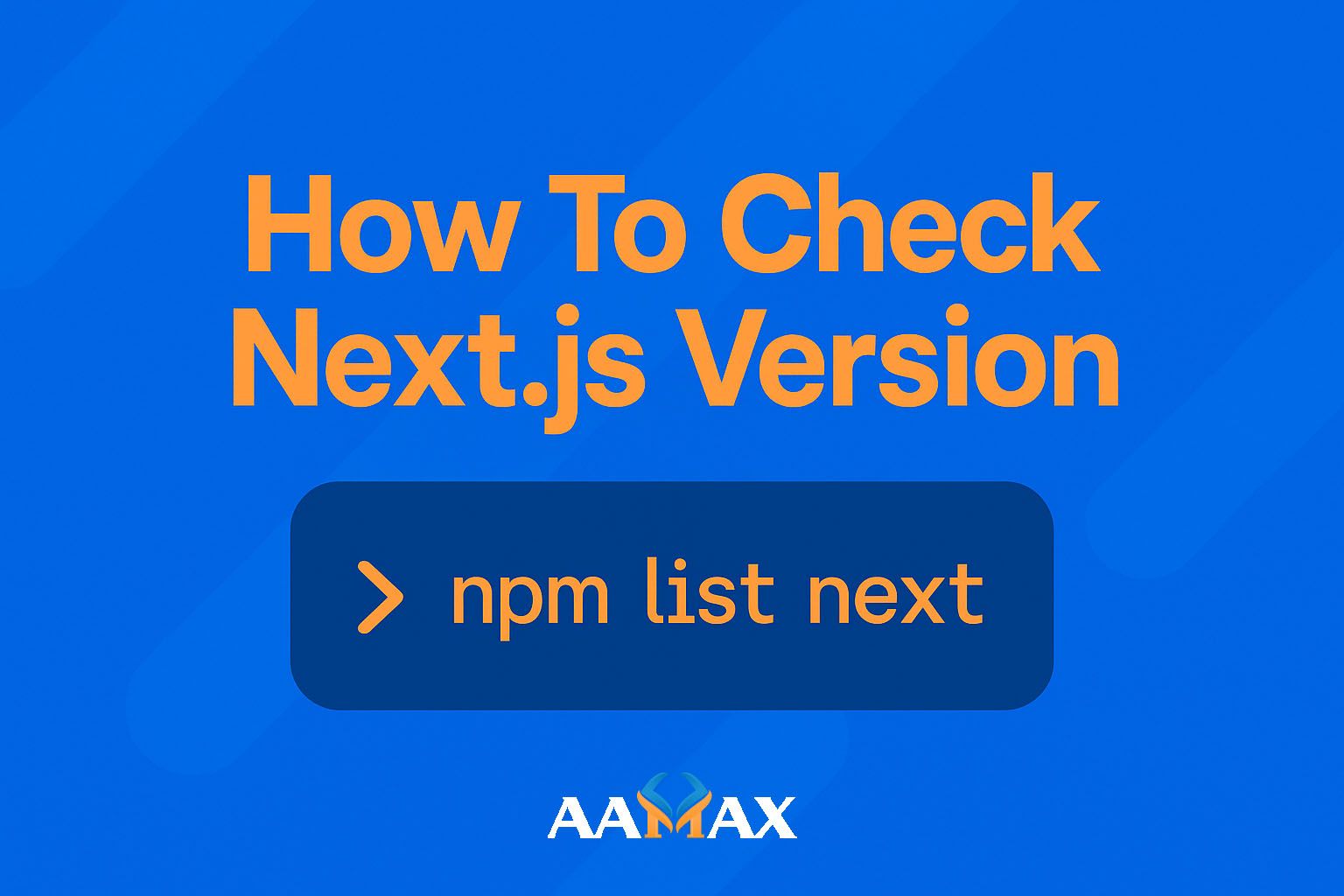
How To Check next.js Version
In this comprehensive guide, we'll cover multiple ways to check the Next.js version in your project, how to interpret version numbers, and best practices for staying up-to-date.
Next.js is one of the most popular frameworks for building fast, scalable, and SEO-friendly React applications. Whether you're maintaining an existing project, debugging compatibility issues, or planning an upgrade, knowing how to check your Next.js version is a fundamental step in your workflow.
Hire AAMAX For Website Development and Digital Marketing Services
🧩 Why It's Important to Know Your Next.js Version
Before diving into the methods, it's important to understand why version awareness matters.
Each Next.js release introduces new features, improvements, bug fixes, or breaking changes. Knowing your version helps you:
- Ensure compatibility with your Node.js and React versions.\
- Follow the right documentation for your installed version.\
- Identify deprecated or updated APIs.\
- Keep your app secure and optimized.\
- Manage migration smoothly when updating to newer versions.
⚙️ Method 1: Check Version via package.json
The simplest and most direct way to check your Next.js version is by
looking at your package.json file located in your project's root
directory.
Steps:
- Open your project folder.\
- Locate and open the
package.jsonfile.\ - Search for the
nextdependency under thedependenciessection.
Example:
"dependencies": {
"next": "14.2.3",
"react": "18.2.0",
"react-dom": "18.2.0"
}
In this example, the Next.js version installed is 14.2.3.
This method works best when you just need a quick look without running any terminal commands.
💻 Method 2: Use npm or yarn Command
If you prefer using the command line, you can check the installed
Next.js version using npm or yarn.
Using npm:
Run this command inside your project directory:
npm list next
Expected output:
my-nextjs-project@1.0.0 /Users/username/projects/my-nextjs-project
└── next@14.2.3
Using yarn:
yarn list --pattern next
This will display the installed version of Next.js.
Pro Tip: If you have multiple projects or global installations, make sure you are in the correct project folder before running the command.
🧠 Method 3: Check Version Using npx
Another quick and simple method is to use npx, which comes bundled with npm.
Run:
npx next --version
or simply:
npx next -v
This command executes the Next.js binary and returns the version installed in your project.
Example output:
Next.js v14.2.3
This is especially helpful if you don't want to dig into configuration files.
🧰 Method 4: Check Global Installation (if applicable)
Sometimes, developers install Next.js globally to run commands outside specific projects. To check a globally installed version, use:
npm list -g next
or
yarn global list --pattern next
This displays whether Next.js is globally installed and what version it is. However, it's generally not recommended to install Next.js globally, as each project should manage its own dependencies.
🔍 Method 5: Check Version via node_modules Folder
If you're curious, you can also inspect the version directly inside your
project's node_modules folder.
-
Navigate to:
node_modules/next/package.json -
Open that file and look for the
"version"key.
Example:
{
"name": "next",
"version": "14.2.3",
...
}
This method isn't as convenient as others but can be useful for manual inspection or debugging version mismatches.
🧾 Understanding Next.js Versioning
Next.js follows semantic versioning (SemVer), which uses the format
MAJOR.MINOR.PATCH (e.g., 14.2.3).
Here's what each part means:
- MAJOR: Introduces breaking changes. (e.g., upgrading from 13.x to 14.x may require code updates.)\
- MINOR: Adds new features but remains backward compatible.\
- PATCH: Fixes bugs or small improvements without breaking compatibility.
For example, upgrading from 14.2.2 → 14.2.3 is safe and typically
doesn't require code changes, while moving from 13.x → 14.x might.
🧭 How to Check Next.js Version in Your Production Build
Sometimes, developers want to confirm the version used in production. You can do this by running a build command and inspecting logs.
Run:
npm run build
During the build process, Next.js logs the version information:
info - Using Next.js v14.2.3
You can also include this version dynamically in your app using Node.js:
const nextVersion = require('next/package.json').version;
console.log("Running Next.js version:", nextVersion);
This can be helpful for debugging and version tracking in CI/CD pipelines.
🧩 Common Issues When Checking Next.js Version
Sometimes, the version you expect doesn't match what's running. Here's why:
- Multiple installations: You might have both global and local versions.\
- Outdated lock files: Your
package-lock.jsonoryarn.lockmight be outdated.\ - Incorrect working directory: Running commands outside your project folder.\
- Cache issues: Old npm or yarn caches can cause confusion.
To fix potential inconsistencies:
rm -rf node_modules
npm install
This will ensure your dependencies are correctly aligned with your
package.json.
🔄 How to Upgrade Next.js Version
Knowing your current version is just the first step --- you should also know how to update it properly.
To upgrade to the latest version:
npm install next@latest
or for a specific version:
npm install next@14.2.3
After updating, check the new version using any of the methods discussed earlier.
It's also a good idea to read the Next.js release notes before upgrading major versions, as breaking changes or migration steps may apply.
💡 Best Practices for Version Management
Here are some key practices for managing your Next.js versions effectively:
- Use version control (Git): Always commit your
package.jsonand lock files.\ - Lock versions in production: Avoid unexpected upgrades by specifying exact versions.\
- Stay updated with the community: Follow the Next.js release notes and changelogs.\
- Use staging environments: Test upgrades before deploying them to production.\
- Maintain dependency hygiene: Regularly run
npm auditto ensure security and stability.
By following these tips, your Next.js projects remain stable, secure, and future-ready.
🚀 Why Developers Choose Next.js
Next.js is widely adopted because of its rich feature set, including:
- Server-side rendering (SSR) for better SEO.\
- Static site generation (SSG).\
- API routes for backend functionality.\
- Image optimization and routing system.\
- Built-in TypeScript and ESLint support.
For businesses looking to build modern, fast, and SEO-optimized web applications, Next.js offers an unmatched developer experience and scalability.
💼 Need Professional Help with Next.js or MERN Stack?
If you're planning to build or upgrade your Next.js project and need expert guidance, you can hire AAMAX --- a full-service digital agency offering MERN Stack Development, Web Development, Digital Marketing, and SEO services.
AAMAX's experienced developers can help you build high-performance applications, manage smooth version upgrades, and ensure your project follows the latest web standards.
👉 Visit AAMAX to get started with expert Next.js and MERN stack development services today!
🧭 Final Thoughts
Knowing how to check your Next.js version is essential for maintaining a
healthy and up-to-date project. From simple checks using package.json
to terminal commands and CI/CD tracking, staying aware of your version
ensures compatibility, stability, and smooth upgrades.
With this guide, you can easily manage and monitor your Next.js environment --- and if you ever need professional help, remember that AAMAX is here to support your development journey.







